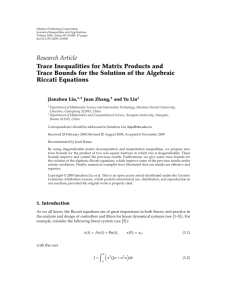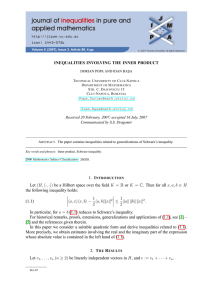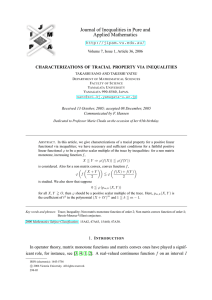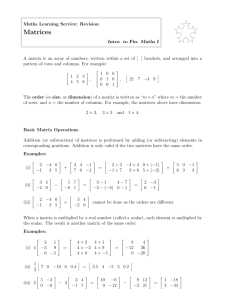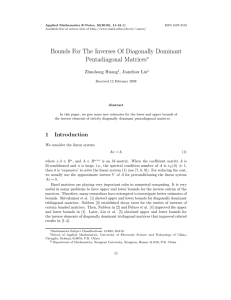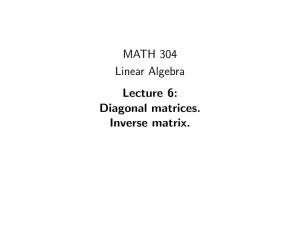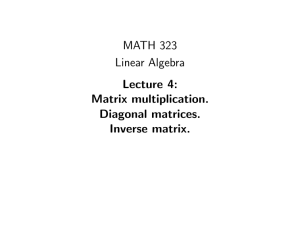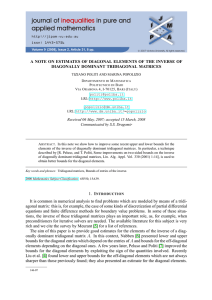Document 10940146
advertisement
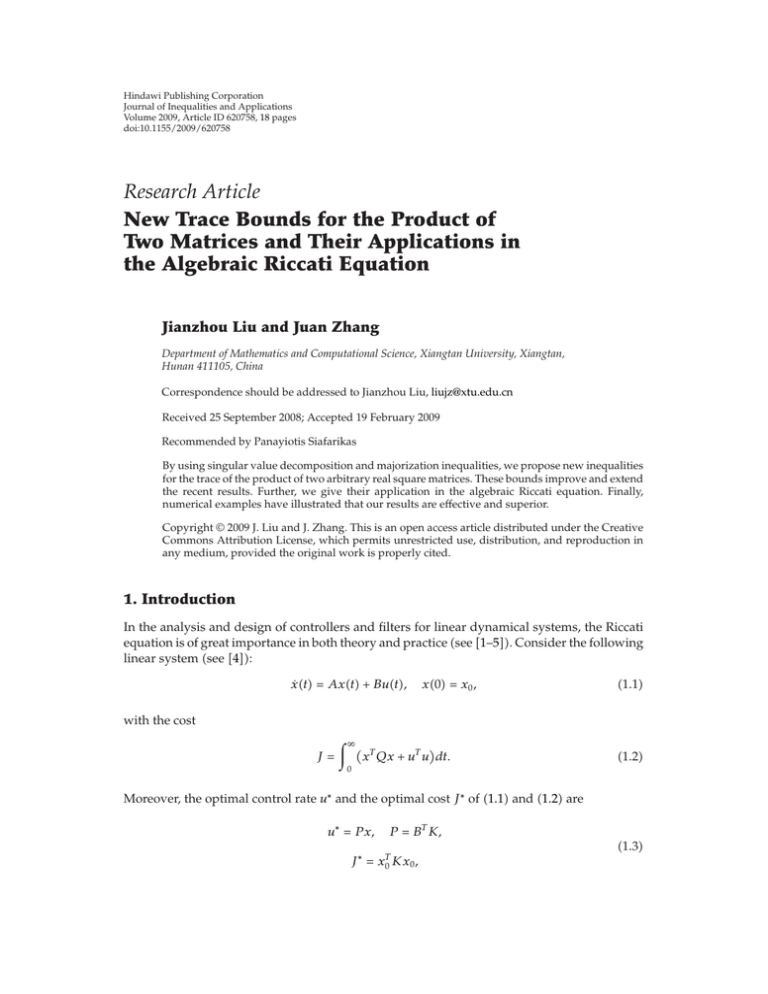
Hindawi Publishing Corporation Journal of Inequalities and Applications Volume 2009, Article ID 620758, 18 pages doi:10.1155/2009/620758 Research Article New Trace Bounds for the Product of Two Matrices and Their Applications in the Algebraic Riccati Equation Jianzhou Liu and Juan Zhang Department of Mathematics and Computational Science, Xiangtan University, Xiangtan, Hunan 411105, China Correspondence should be addressed to Jianzhou Liu, liujz@xtu.edu.cn Received 25 September 2008; Accepted 19 February 2009 Recommended by Panayiotis Siafarikas By using singular value decomposition and majorization inequalities, we propose new inequalities for the trace of the product of two arbitrary real square matrices. These bounds improve and extend the recent results. Further, we give their application in the algebraic Riccati equation. Finally, numerical examples have illustrated that our results are effective and superior. Copyright q 2009 J. Liu and J. Zhang. This is an open access article distributed under the Creative Commons Attribution License, which permits unrestricted use, distribution, and reproduction in any medium, provided the original work is properly cited. 1. Introduction In the analysis and design of controllers and filters for linear dynamical systems, the Riccati equation is of great importance in both theory and practice see 1–5. Consider the following linear system see 4: ẋt Axt But, x0 x0 , 1.1 with the cost J ∞ xT Qx uT u dt. 1.2 0 Moreover, the optimal control rate u∗ and the optimal cost J ∗ of 1.1 and 1.2 are u∗ P x, P BT K, J ∗ x0T Kx0 , 1.3 2 Journal of Inequalities and Applications where x0 ∈ Rn is the initial state of the systems 1.1 and 1.2, K is the positive definite solution of the following algebraic Riccati equation ARE: AT K KA − KRK −Q, 1.4 with R BBT and Q are symmetric positive definite matrices. To guarantee the existence of the positive definite solution to 1.4, we shall make the following assumptions: the pair A, R is stabilizable, and the pair Q, A is observable. In practice, it is hard to solve the ARE, and there is no general method unless the system matrices are special and there are some methods and algorithms to solve 1.4, however, the solution can be time-consuming and computationally difficult, particularly as the dimensions of the system matrices increase. Thus, a number of works have been presented by researchers to evaluate the bounds and trace bounds for the solution of the ARE 6–12. In addition, from 2, 6, we know that an interpretation of trK is that trK/n is the average value of the optimal cost J ∗ as x0 varies over the surface of a unit sphere. Therefore, consider its applications, it is important to discuss trace bounds for the product of two matrices. Most available results are based on the assumption that at least one matrix is symmetric 7, 8, 11, 12. However, it is important and difficult to get an estimate of the trace bounds when any matrix in the product is nonsymmetric in theory and practice. There are some results in 13–15. In this paper, we propose new trace bounds for the product of two general matrices. The new trace bounds improve the recent results. Then, for their application in the algebraic Riccati equation, we get some upper and lower bounds. In the following, let Rn×n denote the set of n × n real matrices. Let x x1 , x2 , . . . , xn be a real n-element array which is reordered, and its elements are arranged in nonincreasing order. That is, x1 ≥ x2 ≥ · · · ≥ xn . Let |x| |x1 |, |x2 |, . . . , |xn |. For A aij ∈ Rn×n , let dA d1 A, d2 A, . . . , dn A, λA λ1 A, λ2 A, . . . , λn A, σA σ1 A, σ2 A, . . . , σn A denote the diagonal elements, the eigenvalues, the singular values of A, respectively, Let trA, AT denote the trace, the transpose of A, respectively. We define Aii aii di A, A A AT /2. The notation A > 0 A ≥ 0 is used to denote that A is a symmetric positive definite semidefinite matrix. Let α, β be two real n-element arrays. If they satisfy k i1 αi ≤ k βi , k 1, 2, . . . , n, 1.5 i1 then it is said that α is controlled weakly by β, which is signed by α≺w β. If α≺w β and n i1 αi n βi , i1 then it is said that α is controlled by β, which is signed by α ≺ β. 1.6 Journal of Inequalities and Applications 3 Therefore, considering the application of the trace bounds, many scholars pay much attention to estimate the trace bounds for the product of two matrices. Marshall and Olkin in 16 have showed that for any A, B ∈ Rn×n , then − n σi Aσi B ≤ trAB ≤ i1 n σi Aσi B. 1.7 i1 Xing et al. in 13 have observed another result. Let A, B ∈ Rn×n be arbitrary matrices with the following singular value decomposition: B Udiag σ1 B, σ2 B, . . . , σn B V T , 1.8 where U, V ∈ Rn×n are orthogonal. Then λn AS n σi B ≤ trAB ≤ λ1 AS i1 n σi B, 1.9 i1 where S UV T is orthogonal. Liu and He in 14 have obtained the following: let A, B ∈ Rn×n be arbitrary matrices with the following singular value decomposition: B Udiag σ1 B, σ2 B, . . . , σn B V T , 1.10 where U, V ∈ Rn×n are orthogonal. Then n n min V T AU ii σi B ≤ trAB ≤ max V T AU ii σi B. 1≤i≤n i1 1≤i≤n 1.11 i1 F. Zhang and Q. Zhang in 15 have obtained the following: let A, B ∈ Rn×n be arbitrary matrices with the following singular value decomposition: B Udiag σ1 B, σ2 B, . . . , σn B V T , 1.12 where U, V ∈ Rn×n are orthogonal. Then n i1 σi Bλn−i1 AS ≤ trAB ≤ n σi Bλi AS, i1 where S UV T is orthogonal. They show that 1.13 has improved 1.9. 1.13 4 Journal of Inequalities and Applications 2. Main Results The following lemmas are used to prove the main results. Lemma 2.1 see 16, page 92, H.2.c. If x1 ≥ · · · ≥ xn , y1 ≥ · · · ≥ yn and x ≺ y, then for any real array u1 ≥ · · · ≥ un , n xi ui ≤ i1 n 2.1 yi ui . i1 Lemma 2.2 see 16, page 95, H.3.b. If x1 ≥ · · · ≥ xn , y1 ≥ · · · ≥ yn and x≺w y, then for any real array u1 ≥ · · · ≥ un ≥ 0, n xi ui ≤ i1 n 2.2 yi ui . i1 Remark 2.3. Note that if x≺w y, then for k 1, 2, . . . , n, x1 , . . . , xk ≺w y1 , . . . , yk . Thus from Lemma 2.2, we have k xi ui ≤ i1 k yi ui , k 1, 2, . . . , n. 2.3 i1 Lemma 2.4 see 16, page 218, B.1. Let A AT ∈ Rn×n , then dA ≺ λA. 2.4 Lemma 2.5 see 16, page 240, F.4.a. Let A ∈ Rn×n , then T A AT AA ≺w λ λ ≺w σA. 2 2 2.5 Lemma 2.6 see 17. Let 0 < m1 ≤ ak ≤ M1 , 0 < m2 ≤ bk ≤ M2 , k 1, 2, . . . , n, 1/p 1/q 1. Then n ak bk ≤ k1 n k1 p ak 1/p 1/q n n q bk ≤ cp,q ak bk , k1 2.6 k1 where p q p q M 1 M2 − m 1 m 2 cp,q . q q 1/p p p 1/q p M1 m2 M2 − m1 M2 m2 q m1 M2 M1 − M1 m2 m1 2.7 Journal of Inequalities and Applications 5 0 or m2 0, m1 / 0, obviously, 2.6 holds. If m1 m2 0, choose Note that if m1 0, m2 / cp,q ∞, then 2.6 also holds. Remark 2.7. If p q 2, then we obtain Cauchy-Schwartz inequality n ak bk ≤ n k1 a2k 1/2 1/2 n n 2 bk ≤ c2 ak bk , k1 k1 2.8 k1 where c2 M1 M2 m1 m2 m1 m2 M1 M2 . 2.9 Remark 2.8. Note that p p p 1/p lim a1 a2 · · · an max ak , p→∞ 1≤k≤n p q p q M1 M2 − m 1 m 2 cp,q lim lim p→∞ p→∞ q q 1/p p p 1/q q m1 M2 M1 − M1 m2 m1 q→1 q → 1 p M1 m2 M2 − m1 M2 m2 p q q M1 M2 − m1 /M1 p m2 lim 1/q p→∞ 1/p q q 1/p q/p M1 q m1 M2 −M1 m2 m1 /M1 p p m2 M2 −m1 /M1 M2 m2 q → 1 M1 M2 1/pp/q−p m1 M2 q → 1 M1 lim p→∞ 1 lim p→∞ 1/p−1 m1 q → 1 M1 M1 . m1 2.10 Let p → ∞, q → 1 in 2.6, then we obtain m1 n bk ≤ k1 n n ak bk ≤ M1 bk . k1 2.11 k1 Lemma 2.9. If q ≥ 1, ai ≥ 0 i 1, 2, . . . , n, then n 1 ai n i1 q ≤ n 1 q a . n i1 i 2.12 6 Journal of Inequalities and Applications Proof. 1 Note that q 1, or ai 0 i 1, 2, . . . , n, n 1 ai n i1 q n 1 q ai . n i1 2.13 2 If q > 1, ai > 0, for x > 0, choose fx xq , then f x qxq−1 > 0 and f x qq − 1xq−2 > 0. Thus, fx is a convex function. As ai > 0 and 1/n ni1 ai > 0, from the property of the convex function, we have n 1 ai n i1 q f n 1 ai n i1 ≤ n n 1 1 q fai a . n i1 n i1 i 2.14 3 If q > 1, without loss of generality, we may assume ai 0 i 1, . . . , r, ai > 0 i r 1, . . . , n. Then from 2, we have 1 n−r q q q n n n 1 1 q ai ai ≤ ai . n − r n − r i1 i1 i1 2.15 Since n − r/nq ≤ n − r/n, thus n 1 ai n i1 q n−r n q 1 n−r q q n n n n−r 1 1 q q ai ≤ ai ai . n n − r n i1 i1 i1 2.16 This completes the proof. Theorem 2.10. Let A, B decomposition: ∈ Rn×n be arbitrary matrices with the following singular value B Udiagσ1 B, σ2 B, . . . , σn BV T , 2.17 where U, V ∈ Rn×n are orthogonal. Then n n σi Bdn−i1 V T AU ≤ trAB ≤ σi Bdi V T AU . i1 2.18 i1 Proof. By the matrix theory we have trAB tr AUdiag σ1 B, σ2 B, . . . , σn B V T tr V T AUdiag σ1 B, σ2 B, . . . , σn B n i1 σi B V T AU ii . 2.19 Journal of Inequalities and Applications 7 Since σ1 B ≥ σ2 B ≥ · · · ≥ σn B ≥ 0, without loss of generality, we may assume σB σ1 B, σ2 B, . . . , σn B. Next, we will prove the left-hand side of 2.18: n n σi Bdn−i1 V T AU ≤ σi Bdi V T AU . i1 2.20 i1 If d V T AU dn V T AU , dn−1 V T AU , . . . , d1 V T AU , 2.21 we obtain the conclusion. Now assume that there exists j < k such that dj V T AU > dk V T AU, then σj Bdk V T AU σk Bdj V T AU − σj Bdj V T AU − σk Bdk V T AU σj B − σk B dk V T AU − dj V T AU ≤ 0. 2.22 T AU to denote the vector of dV T AU after changing dj V T AU and dk V T AU, We use dV then n n σi Bdi V T AU ≤ σi Bdi V T AU . i1 2.23 i1 After limited steps, we obtain the the left-hand side of 2.18. For the right-hand side of 2.18, n n σi Bdi V T AU ≤ σi Bdi V T AU . i1 2.24 i1 If d V T AU d1 V T AU , d2 V T AU , . . . , dn V T AU , 2.25 we obtain the conclusion. Now assume that there exists j > k such that dj V T AU < dk V T AU, then σj Bdk V T AU σk Bdj V T AU − σj Bdj V T AU − σk Bdk V T AU σj B − σk B dk V T AU − dj V T AU ≥ 0. 2.26 8 Journal of Inequalities and Applications T AU to denote the vector of dV T AU after changing dj V T AU and dk V T AU, We use dV then n n σi Bdi V T AU ≤ σi Bdi V T AU . i1 2.27 i1 After limited steps, we obtain the right-hand side of 2.18. Therefore, n n σi Bdn−i1 V T AU ≤ trAB ≤ σi Bdi V T AU . i1 2.28 i1 This completes the proof. Since trAB trBA, applying 2.18 with B in lieu of A, we immediately have the following corollary. Corollary 2.11. Let A, B ∈ Rn×n be arbitrary matrices with the following singular value decomposition: A P diagσ1 A, σ2 A, . . . , σn AQT , 2.29 where P, Q ∈ Rn×n are orthogonal. Then n n σi Adn−i1 QT BP ≤ trAB ≤ σi Adi QT BP . i1 2.30 i1 Now using 2.18 and 2.30, one finally has the following theorem. Theorem 2.12. Let A, B ∈ Rn×n be arbitrary matrices with the following singular value decompositions, respectively: A P diag σ1 A, σ2 A, . . . , σn A QT , B Udiag σ1 B, σ2 B, . . . , σn B V T , 2.31 where P, Q, U, V ∈ Rn×n are orthogonal. Then n n T T σi Adn−i1 Q BP , σi Bdn−i1 V AU max i1 ≤ trAB ≤ min i1 n i1 σi Bdi n T T V AU , σi Adi Q BP . i1 2.32 Journal of Inequalities and Applications 9 Remark 2.13. We point out that 2.18 improves 1.11. In fact, it is obvious that n n min V T AU ii σi B ≤ σi Bdn−i1 V T AU 1≤i≤n i1 2.33 i1 ≤ trAB ≤ n n σi Bdi V T AU ≤ max V T AU ii σi B. 1≤i≤n i1 i1 This implies that 2.18 improves 1.11. Remark 2.14. We point out that 2.18 improves 1.13. Since for i 1, . . . , n, σi B ≥ 0 and T di V T AU di V T AU V T AU /2, from Lemmas 2.1 and 2.4, then 2.18 implies n σi Bλn−i1 i1 T V T AU V T AU 2 n ≤ σi Bdn−i1 i1 T V T AU V T AU 2 ≤ trAB 2.34 n ≤ σi Bdi T V T AU V T AU 2 T V T AU V T AU . 2 i1 n ≤ σi Bλi i1 In fact, for i 1, 2, . . . , n, we have λi V T AU V T AU 2 T T AUV T AUV T λi V V 2 T λi AUV T AUV T 2 λi AS. T 2.35 10 Journal of Inequalities and Applications Then 2.34 can be rewritten as n n σi Bλn−i1 AS ≤ σi Bdn−i1 V T AU i1 i1 ≤ trAB ≤ n σi Bdi V T AU 2.36 i1 ≤ n σi Bλi AS. i1 This implies that 2.18 improves 1.13. Remark 2.15. We point out that 1.13 improves 1.7. In fact, from Lemma 2.5, we have 2.37 λAS≺w σAS. Since S is orthogonal, σAS σA. Then 2.37 is rewritten as follows: λAS≺w σA. By using σ1 B ≥ σ2 B ≥ · · · ≥ σn B ≥ 0 and Lemma 2.2, we obtain n n σi Bλi AS ≤ σi Bσi A. i1 2.38 i1 Note that λi −AS −λn−i1 AS, from Lemma 2.2 and 2.38, we have − n n σi Bλn−i1 AS σi Bλi −AS i1 i1 ≤ n n σi Bλi AS ≤ σi Bσi A. i1 2.39 i1 Thus, we obtain − n i1 σi Bσi A ≤ n σi Bλn−i1 AS. i1 Both 2.38 and 2.40 show that 1.13 is tighter than 1.7. 2.40 Journal of Inequalities and Applications 11 3. Applications of the Results Wang et al. in 6 have obtained the following: let K be the positive semidefinite solution of the ARE 1.4. Then the trace of matrix K has the lower and upper bounds given by λn A 2 λ1 A λn A λ1 RtrQ ≤ trK ≤ λ1 R 2 λ1 A λn R/ntrQ . λn R/n 3.1 In this section, we obtain the application in the algebraic Riccati equation of our results including 3.1. Some of our results and 3.1 cannot contain each other. Theorem 3.1. If 1/p 1/q 1 and K is the positive semidefinite solution of the ARE 1.4, then 1 the trace of matrix K has the lower and upper bounds given by λn A 2 n p 1/p trQ λn A i1 λi R 1/p p i1 λi R n ≤ trK ≤ λ1 A λ1 A 2 1/cp,q 1/cp,q n2−1/q n2−1/q n p 1/p p i1 λi R n i1 λi R 1/p 3.2 trQ . 2 If A AT /2 ≥ 0, then the trace of matrix K has the lower and upper bounds given by n1−1/q 1/cp,q 1/p p i1 λi A n 1/p 2 n p 1/p n p n1−1/q trQ 1/cp,q i1 λi A i1 λi R 1/p n p i1 λi R ≤ trK 1/p p i1 λi A n ≤ n 2/p p i1 λi A 1/p n p 1/cp,q n2−1/q trQ i1 λi R . 1/p p n 1/cp,q n2−1/q i1 λi R 3.3 12 Journal of Inequalities and Applications 3 If A AT /2 ≤ 0, then the trace of matrix K has the lower and upper bounds given by p 1/p − ni1 λn−i1 A p 2/p 1/p n n p 1/cp,q n2−1/q trQ i1 λn−i1 A i1 λi R 1/p n p 1/cp,q n2−1/q i1 λi R ≤ trK p 1/p n − 1/cp,q n1−1/q i1 λn−i1 A 1/p n p i1 λi R ≤ n1−1/q 1/cp,q p 1/p 2 n p 1/p n trQ i1 λi A i1 λi R , 1/p n p λ R i1 i 3.4 where p cp,q Mr λ1 R, mr λn R, p cp,q q p q M r Mk − m r m k , q q 1/p p p 1/q p Mr mk Mk − mr Mk mk q mr Mk Mr − Mr mk mr Mk λ1 K, q p mk λn K, q M 1 Mk − m 1 m k , q q 1/p p p 1/q p M1 mk Mk − m1 Mk mk q m1 Mk M1 − M1 mk m1 M1 λ1 A, 3.5 m1 λn A. Proof. 1 Take the trace in both sides of the matrix ARE 1.4 to get tr AT K trKA − trKRK −trQ. Since K is symmetric positive definite matrix, λK σK, trK Lemma 2.9, we have 3.6 n trK q 1/q ≤ tr K ≤ trK, n1−1/q 2 n n n 2 2 σi KK σi K ≤ σi K trK . i1 i1 i1 i1 σi K, and from 3.7 3.8 Journal of Inequalities and Applications 13 By the Cauchy-Schwartz inequality 2.8, it can be shown that n n 2 σi KK σi K ≥ i1 n i1 σi K 2 n i1 2 trK . n 3.9 Note that K 2 Udiagλ21 K, λ22 K, . . . , λ2n KUT , 3.10 K, Q, R > 0, λi UT RU λi R i 1, . . . , n, then by 2.34, use 2.6, considering 3.7 and 3.9, we have n λi Rσi K 2 trKRK tr K 2 R ≥ i1 ≥ 1 cp,q n i1 p λi R 1/q 1/p n q 2 σi K 3.11 i1 1/p n 2 1 p ≥ λi R trK . 2−1/q cp,q n i1 From 2.34, note that λi UT AU λi A and λi UT AT U λi AT i 1, . . . , n, then we obtain trAK ≤ n n λi Aσi K ≤ λ1 A σi K, i1 trAT K ≤ n i1 λi AT σi K ≤ λ1 AT i1 n 3.12 σi K. i1 It is easy to see that trAT K trKA ≤ λ1 AT trK λ1 AtrK trK 2λ1 AT A trK 2λ1 AtrK. 2 3.13 Combine 3.11 and 3.13, we obtain 1/p n 2 1 p λ R trK − 2trKλn A − trQ ≤ 0. cp,q n2−1/q i1 i 3.14 Solving 3.14 for trK yields the right-hand side of the inequality 3.2. Similarly, we can obtain the left-hand side of the inequality 3.2. 14 Journal of Inequalities and Applications 2 Note that when A AT /2 ≥ 0, λi UT AU λi A and λi UT AT U λi A i 1, . . . , n, by 2.34, 2.6 and 3.7, we have T 1/p n T p T λi A trK, tr A K ≤ i1 3.15 1/p n p λi A trK. trKA ≤ i1 Thus, tr AT K trKA ≤ n i1 1/p p λi AT n i1 p λi A trK 1/p T n A A p λi trK ≤2 2 i1 3.16 1/p n p λi A trK. 2 i1 From 3.11 and 3.16, with similar argument to 1, we can obtain 3.3 easily. 3 Note that when A AT /2 ≤ 0, by 3.3, we obtain 3.4 immediately. This completes the proof. Remark 3.2. From Remark 2.7 and Theorem 3.1, let p 2, q 2 in 3.2, then we obtain λn A 2 n 2 1/2 trQ λn A i1 λi R 1/2 n 2 i1 λi R ≤ trK ≤ λ1 A 2 1/2 n 2 λ1 A 1/c1 n3/2 trQ i1 λi R , 1/2 n 2 1/c1 n3/2 i1 λi R 3.17 where c1 Mr Mk /mr mk mr mk /Mr Mk . Remark 3.3. From Remark 2.7 and Theorem 3.1, let p → ∞, q → 1 in 3.2, then we obtain 3.1 immediately. 4. Numerical Examples In this section, firstly, we will give two examples to illustrate that our new trace bounds are better than the recent results. Then, to illustrate the application in the algebraic Riccati Journal of Inequalities and Applications 15 equation of our results will have different superiority if we choose different p and q, we will give two examples when p 2, q 2, and p → ∞, q → 1. Example 4.1 see 13. Now let ⎛ ⎞ 0.9140 0.6989 0.6062 ⎜ ⎟ ⎜ ⎟ A ⎜0.2309 0.0169 0.04501⎟, ⎝ ⎠ 0.3471 0.5585 0.0304 ⎛ 0.9892 0.1140 0.1233 4.1 ⎞ ⎜ ⎟ ⎜ ⎟ B ⎜0.0410 0.3096 0.5125⎟. ⎝ ⎠ 0.0476 0.7097 0.0962 Neither A nor B is symmetric. In this case, the results of 6–12 are not valid. Using 1.9 we obtain 0.78 ≤ trAB ≤ 1.97. 4.2 0.8611 ≤ trAB ≤ 1.9090. 4.3 1.0268 ≤ trAB ≤ 1.7524, 4.4 Using 1.11 yields By 2.18, we obtain where both lower and upper bounds are better than those of 4.2 and 4.3. Example 4.2. Let ⎛ 0.0624 0.8844 0.2782 0.0389 ⎞ ⎟ ⎜ ⎜0.7163 0.6565 0.2923 0.5980⎟ ⎟ ⎜ ⎟, A⎜ ⎟ ⎜ ⎜0.5502 0.2660 0.5486 0.3376⎟ ⎠ ⎝ 0.1134 0.5739 0.3999 0.2792 ⎛ 1.7205 0.6542 1.3030 0.8813 ⎞ ⎟ ⎜ ⎜0.6542 0.0631 0.6191 0.2696⎟ ⎟ ⎜ ⎟. B⎜ ⎟ ⎜ ⎜1.3030 0.6191 0.4715 0.7551⎟ ⎠ ⎝ 0.8813 0.2696 0.7551 0.4584 Neither A nor B is symmetric. In this case, the results of 6–12 are not valid. 4.5 16 Journal of Inequalities and Applications Using 1.7 yields −6.1424 ≤ trAB ≤ 6.1424. 4.6 −1.5007 ≤ trAB ≤ 5.0110. 4.7 −3.1058 ≤ trAB ≤ 6.0736. 4.8 −0.7267 ≤ trAB ≤ 4.3399. 4.9 −0.5375 ≤ trAB ≤ 4.2659. 4.10 From 1.9 we have Using 1.11 yields By 1.13, we obtain The bound in 2.18 yields Obviously, 4.10 is tighter than 4.6, 4.7, 4.8 and 4.9. Example 4.3. Consider the systems 1.1, 1.2 with ⎛ ⎞ −5 −2 4 ⎜ ⎟ ⎜ ⎟ A ⎜ 2 3 −1⎟, ⎝ ⎠ 1 0 −3 ⎛ ⎞ 8 2 3 ⎟ ⎜ ⎜ ⎟ BBT ⎜2 7 4⎟, ⎠ ⎝ 3 4 9 ⎛ 538 440 266 ⎞ ⎜ ⎟ ⎜ ⎟ Q ⎜440 441 321⎟. ⎝ ⎠ 266 321 296 4.11 Moreover, the corresponding ARE 1.4 with R BBT , A, R is stabilizable and Q, A is observable. Using 3.17 yields 8.5498 ≤ trK ≤ 47.9041. 4.12 9.0132 ≤ trK ≤ 19.0099, 4.13 Using 3.1 we obtain where both lower and upper bounds are better than those of 4.12. Journal of Inequalities and Applications 17 Example 4.4. Consider the systems 1.1, 1.2 with ⎛ −6.0 1.5 2.0 ⎞ ⎜ ⎟ ⎜ ⎟ A ⎜ 0.0 −2.0 −3.0⎟, ⎝ ⎠ 2.5 4.0 −1.5 ⎛ 4.0 1.0 2.0 ⎞ ⎜ ⎟ ⎜ ⎟ BBT ⎜1.0 2.0 0.5⎟, ⎝ ⎠ 2.0 0.5 2.5 ⎛ 17.5 7.45 3.465 ⎞ ⎜ ⎟ ⎜ ⎟ Q ⎜ 7.45 9.7 7.845⎟. ⎝ ⎠ 3.465 7.845 9.905 4.14 Moreover, the corresponding ARE 1.4 with R BB T , A, R is stabilizable and Q, A is observable. Using 3.1 we obtain 1.6039 ≤ trK ≤ 5.6548. 4.15 1.6771 ≤ trK ≤ 5.5757, 4.16 Using 3.17 yields where both lower and upper bounds are better than those of 4.15. 5. Conclusion In this paper, we have proposed lower and upper bounds for the trace of the product of two arbitrary real matrices. We have showed that our bounds for the trace are the tightest among the parallel trace bounds in nonsymmetric case. Then, we have obtained the application in the algebraic Riccati equation of our results. Finally, numerical examples have illustrated that our bounds are better than the recent results. Acknowledgments The author thanks the referee for the very helpful comments and suggestions. The work was supported in part by National Natural Science Foundation of China 10671164, Science and Research Fund of Hunan Provincial Education Department 06A070. References 1 K. Kwakernaak and R. Sivan, Linear Optimal Control Systems, John Wiley & Sons, New York, NY, USA, 1972. 2 D. L. Kleinman and M. Athans, “The design of suboptimal linear time-varying systems,” IEEE Transactions on Automatic Control, vol. 13, no. 2, pp. 150–159, 1968. 3 R. Davies, P. Shi, and R. Wiltshire, “New upper solution bounds for perturbed continuous algebraic Riccati equations applied to automatic control,” Chaos, Solitons & Fractals, vol. 32, no. 2, pp. 487–495, 2007. 4 M.-L. Ni, “Existence condition on solutions to the algebraic Riccati equation,” Acta Automatica Sinica, vol. 34, no. 1, pp. 85–87, 2008. 5 K. Ogata, Modern Control Engineering, Prentice-Hall, Upper Saddle River, NJ, USA, 3rd edition, 1997. 18 Journal of Inequalities and Applications 6 S.-D. Wang, T.-S. Kuo, and C.-F. Hsu, “Trace bounds on the solution of the algebraic matrix Riccati and Lyapunov equation,” IEEE Transactions on Automatic Control, vol. 31, no. 7, pp. 654–656, 1986. 7 J. B. Lasserre, “Tight bounds for the trace of a matrix product,” IEEE Transactions on Automatic Control, vol. 42, no. 4, pp. 578–581, 1997. 8 Y. Fang, K. A. Loparo, and X. Feng, “Inequalities for the trace of matrix product,” IEEE Transactions on Automatic Control, vol. 39, no. 12, pp. 2489–2490, 1994. 9 J. Saniuk and I. Rhodes, “A matrix inequality associated with bounds on solutions of algebraic Riccati and Lyapunov equations,” IEEE Transactions on Automatic Control, vol. 32, no. 8, pp. 739–740, 1987. 10 T. Mori, “Comments on “A matrix inequality associated with bounds on solutions of algebraic Riccati and Lyapunov equation”,” IEEE Transactions on Automatic Control, vol. 33, no. 11, pp. 1088–1091, 1988. 11 J. B. Lasserre, “A trace inequality for matrix product,” IEEE Transactions on Automatic Control, vol. 40, no. 8, pp. 1500–1501, 1995. 12 P. Park, “On the trace bound of a matrix product,” IEEE Transactions on Automatic Control, vol. 41, no. 12, pp. 1799–1802, 1996. 13 W. Xing, Q. Zhang, and Q. Wang, “A trace bound for a general square matrix product,” IEEE Transactions on Automatic Control, vol. 45, no. 8, pp. 1563–1565, 2000. 14 J. Liu and L. He, “A new trace bound for a general square matrix product,” IEEE Transactions on Automatic Control, vol. 52, no. 2, pp. 349–352, 2007. 15 F. Zhang and Q. Zhang, “Eigenvalue inequalities for matrix product,” IEEE Transactions on Automatic Control, vol. 51, no. 9, pp. 1506–1509, 2006. 16 A. W. Marshall and I. Olkin, Inequalities: Theory of Majorization and Its Applications, vol. 143 of Mathematics in Science and Engineering, Academic Press, New York, NY, USA, 1979. 17 C.-L. Wang, “On development of inverses of the Cauchy and Hölder inequalities,” SIAM Review, vol. 21, no. 4, pp. 550–557, 1979.
